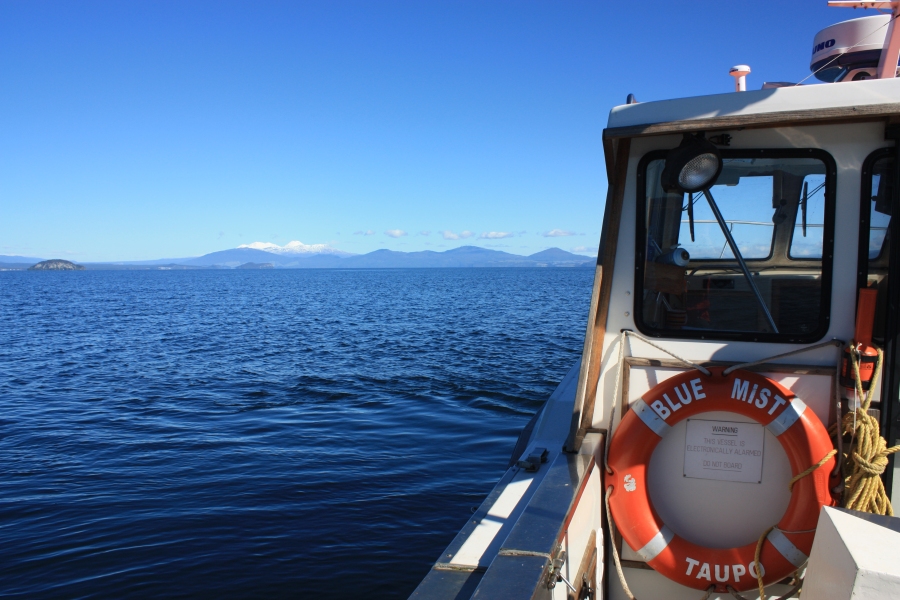During summer the concentration of oxygen in the bottom waters, or 'hypolimnion' of Lake Taupo decreases. To find out what factors are responsible for the total oxygen decrease, NIWA scientists have been monitoring the inputs and outputs of oxidisable matter to the lake.
Our research will help us understand any long-term changes to the lake that may result in unacceptable declines in lake oxygen.
Sources of oxidisable matter
Two main factors are responsible for consuming oxygen:
- the oxidation of organic matter
- the oxidation of sulfide released by geothermal sources in the lake bed.
Organic matter can be split in two components:
- organic matter that is produced within the lake by algae – 'autochthonous' inputs
- organic matter that is produced outside the lake and is carried from the catchment into the lake by streams – 'allochthonous' inputs.
Constructing a mass balance of oxygen
Oxygen concentration data have been compiled for the period from 1994 to the present. From these data oxygen consumption rates have been determined for several water layers since 1994. In particular we are interested in hypolimnetic oxygen consumption during the summer period, when exchange with the surface layer and renewal of oxygen content is minimal. Oxygen concentrations in the hypolimnion are at their minimum in late summer.
Autochthonous inputs of organic matter were determined by measuring the rate of photosynthesis of lake plankton at two-monthly intervals.
Allochthonous organic matter inputs to Lake Taupo have been quantified by monthly collection of water samples from the 12 main rivers entering Lake Taupo, analysis of the samples for total organic carbon, and extrapolation to catchment-wide inputs of organic carbon. We also measured organic carbon in the outflowing Waikato River, to provide an estimate of the organic matter leaving Lake Taupo without undergoing oxidation.
Other geochemical pathways were also taken into account. The concentration of SO4, the oxidized form of sulfur, in the water column in the lake, and in the 12 major inflowing rivers, was determined to examine the importance of internal sources of sulfide in the lake.
Combining the water quality results with the flow rates of each river enabled us to produce a mass balance - in other words, the net amount of organic matter in the lake that is available for oxidation.
Key findings
Oxidation of organic matter could account for the rate of oxygen consumption in the hypolimnion.
The inputs of SO4 by the catchment was sufficient to account for the SO4 present in the lake, suggesting that inputs of geothermal sulfide at sites within the lake were negligible, leaving organic matter oxidation as the single most important process on oxygen loss in the study year.
Allochthonous carbon sources in Lake Taupo were much smaller than autochthonous carbon sources. Organic matter produced by photosynthesis by algae in the lake accounted for 96% of the total amount of organic matter in the lake and was more than sufficient to account for oxygen depletion in the hypolimnion.
Interestingly, the amount of organic carbon leaving the lake through the outflow was slightly larger than the total amount of organic carbon entering the lake from the catchment. This result means that the lake is ‘autotrophic’, i.e., the lake absorbs more CO2 from the atmosphere than it releases to the atmosphere.
The results are relevant for the management of the lake, as the rate of hypolimnetic oxygen consumption is generally a good indicator of trophic enrichment.
It is important to know that geothermal sulfide oxydation does not play a substantial role in the hypolimnetic oxygen consumption in Lake Taupo. Geothermal inputs of reduced sulfide are not related to human activity and therefore cannot be managed, while inputs of organic matter can be managed, especially by controlling nutrients flowing into the lake.
Fortunately, in Lake Taupo oxygen concentrations near the bottom remain fairly high throughout the year, rarely falling below 7 mg per litre and are always above the minimum needed for its fauna to thrive even in the deepest areas. Because the oxygen concentration in bottom waters is a good indicator of change in water quality, managers will continue to include it in the lake monitoring programme.
Acknowledgements
Environment Waikato assisted with water sampling, and samples were tested at NIWA's Water Quality Laboratory in Hamilton.
Contact: Piet Verburg


